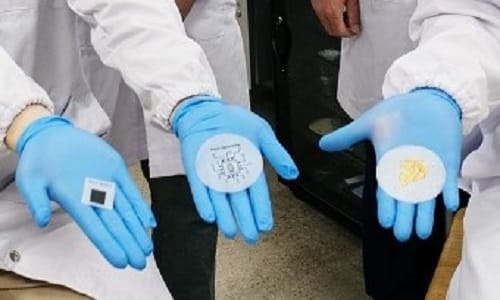Developed using screen printing, the internal structure of the new battery is made to be a much better eco-friendly option

In a step towards realising the recyclability of e-waste, and also powering flexible electronics such as foldable smartphones and biomedical sensors in a sustainable manner, scientists from Nanyang Technological University, Singapore (NTU Singapore) have developed paper-thin biodegradable zinc batteries in which electrodes are screen-printed onto both sides of a piece of hydrogel-reinforced cellulose paper.
Upon full utilisation of the battery, it can be buried in the soil to break down completely within a month.
“Traditional batteries come in a variety of models and sizes, and choosing the right type for your device could be a cumbersome process. Through our study, we showed a simpler, cheaper way of manufacturing batteries, by developing a single large piece of battery that can be cut to desired shapes and sizes without loss of efficiency. These features make our paper batteries ideal for integration in the sorts of flexible electronics that are gradually being developed,” said Professor Fan Hongjin from the NTU School of Physical and Mathematical Sciences.
Assistant Professor Lee Seok Woo from the NTU School of Electrical and Electronic Engineering added, “We believe the paper battery we have developed could potentially help with the electronic waste problem, given that our printed paper battery is non-toxic and does not require aluminium or plastic casings to encapsulate the battery components. Avoiding the packaging layers also enables our battery to store a higher amount of energy, and thus power, within a smaller system.”
Innovative battery design
The 4cm x 4cm and 0.4mm thick (similar to two strands of human hair) printed paper battery was developed using a “sandwich design” – the electrodes being the bread slices, and the cellulose paper with the printed electrodes like the sandwich filling.
The cellulose paper was embedded with hydrogel to create a separator that prevented the mixing of the electrodes, while the electrodes including anode and cathode were made up of zinc and carbon, and manganese and nickel, respectively.
Finally, the battery was immersed in an electrolyte, and a layer of gold thin foil was coated on the electrodes for increased conductivity.
The finished result was successfully demonstrated to power a small electric fan for at least 45 minutes and illuminate a LED. Despite being bent, twisted or cut, the functionality of the flexible battery remained unaffected.
Highly biodegradable
With the help of bacteria and other microorganisms, hydrogel and cellulose were naturally broken down when buried in the soil.
“When decomposition happens, the electrode materials are released into the environment. The nickel or manganese used in the cathodes will remain in their oxide or hydroxide forms, which are close to the form of natural minerals. The zinc found in the anode will be naturally oxidised to form a non-toxic hydroxide. This points to the battery’s potential as a more sustainable alternative to current batteries,” said Prof Fan.
The development of printed paper zinc batteries is in line with the NTU 2025 vision and the University’s Sustainability Manifesto, which aspire to develop sustainable solutions for addressing some of humanity’s pressing grand challenges.
Going forward, the NTU team hopes to demonstrate the complete integration of the printed paper battery to other printed electronics, electronic skins, as well as energy storage systems deployed in the environment.












